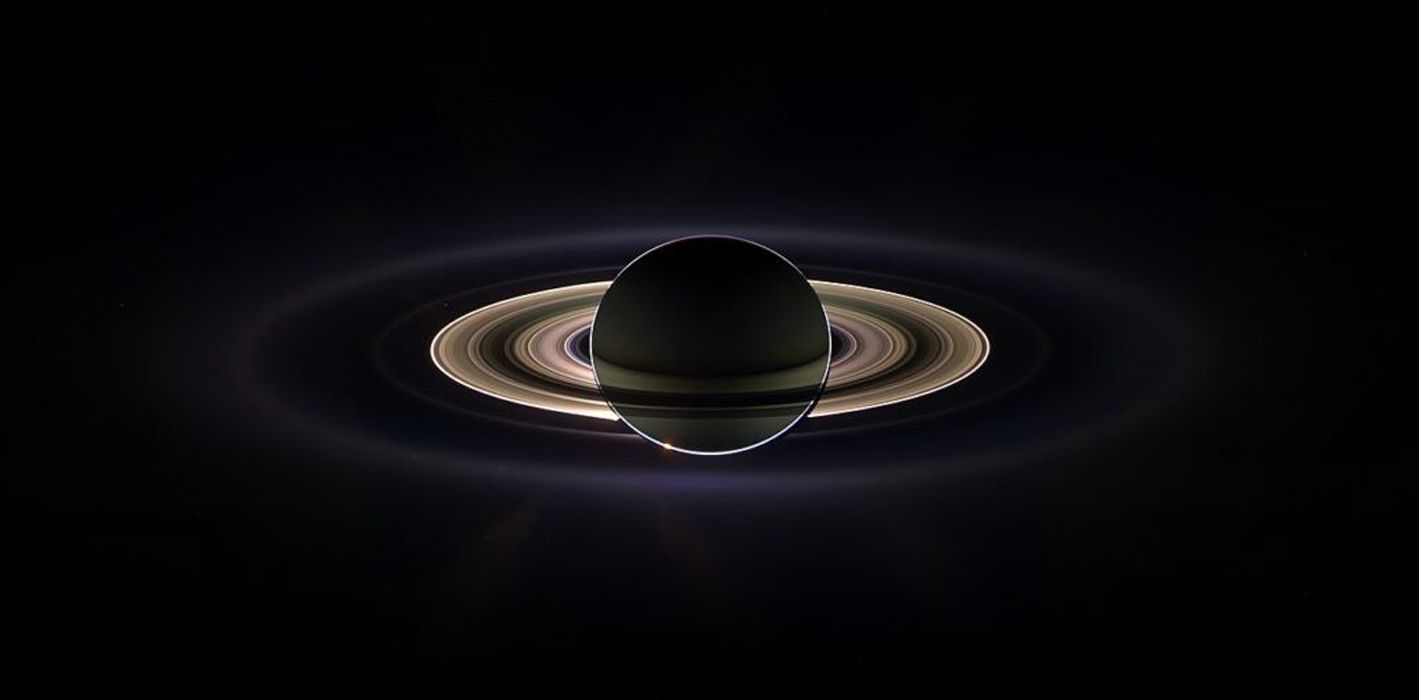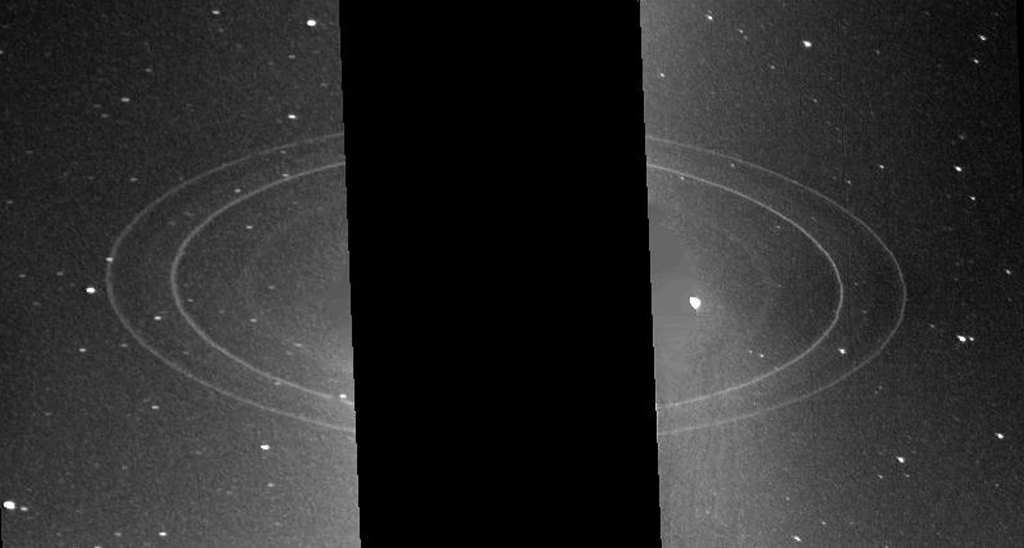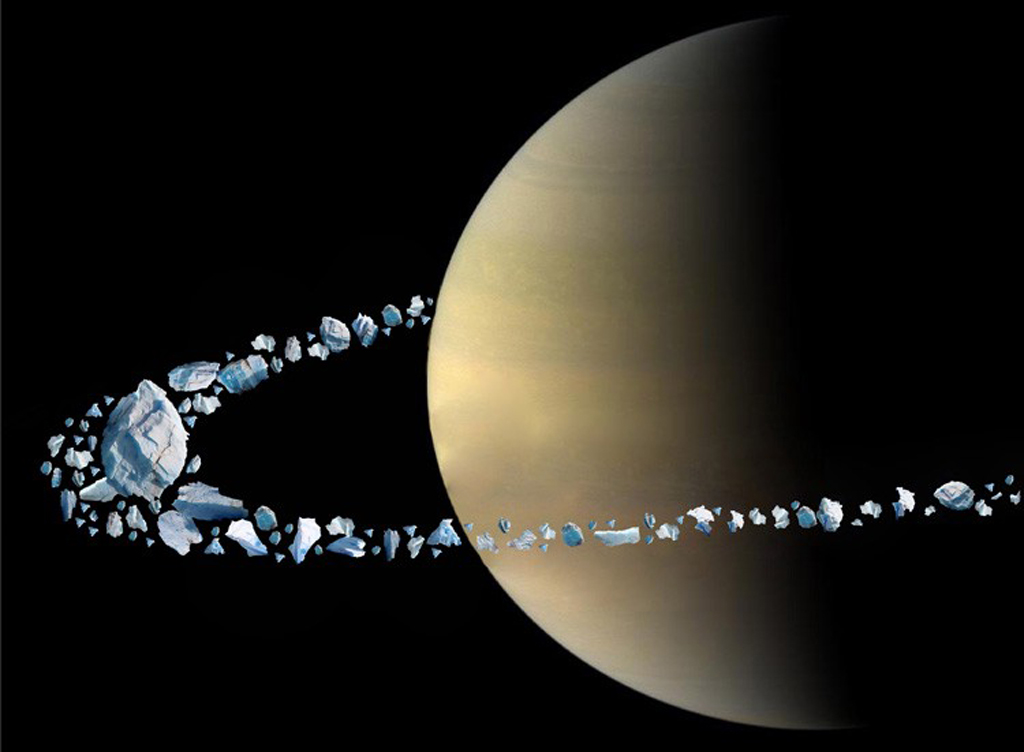Scientists have used computer modeling to determine that Saturn’s rings were created by the interactions of a now-destroyed moon with Titan.

Ask almost any astronomer, professional or amateur, what got them interested in space and almost every one of them will have a story about the first time they looked through a telescope and saw Saturn. I still remember my first time, using a cheap, department store telescope my foster brother gave me. My father set it up in the backyard and pointed it at Saturn, and there were those rings. I was in awe, and it stuck with me. There is something about seeing Saturn’s rings with your own eyes through a tiny lens that brings out the astronomer in everyone. No matter the age of the audience, pointing a scope at Saturn is a surefire way to bring out the oohs and aahs at any star party.
Those rings are gorgeous. And while Saturn isn’t unique for having rings — Jupiter, Uranus, and Neptune all have ring systems — those rings are unique in that they can be seen with a basic telescope from Earth. To see the rings of the other giant planets, you need massive telescopes or spacecraft. Uranus’s rings were discovered in 1977, and since then, Voyager 2 and Hubble observations have led to the identification of thirteen distinct rings. Jupiter’s rings were first seen with Voyager back in 1979 and most recently imaged in the infrared with JWST. And while there were hints that Neptune had rings, they weren’t conclusively found until Voyager 2 swung by the ice giant back in 1989.
Obviously, ring systems are easy to acquire for giant planets, but the question still remains of how Saturn’s system is so much bigger and brighter than the other three systems. Saturn’s rings extend out from the planet’s equator starting 7,000 kilometers from the cloud layers and going all the way out to 80,000 kilometers. They are almost entirely made of water ice, which is another huge difference between the giant planets — Jupiter and Neptune’s rings are mostly dust.

In the past decade or so, many scientists have studied the extensive data collected by the Cassini mission to understand just how and when Saturn’s rings came to be. Back in 2019, the age of the rings was determined to only be about 100 million years, which is very young by our solar system’s standards. And now in a new paper published in Science and led by Jack Wisdom, scientists have figured out what might have happened to create the rings — a large moon of Saturn was likely torn apart by tidal forces, leaving behind all that water ice.
The scientists have named this possible moon Chrysalis, as in what a caterpillar becomes before it transforms into a butterfly. (Sometimes, astronomers are good at naming things.) Using computer simulations, the team found that this potential former moon was close in size to Saturn’s third largest moon, Iapetus.
As to how the moon ended up being torn apart, that involves — oddly enough — Neptune and — not so oddly — Saturn’s other moon, Titan, which is second only to Jupiter’s Ganymede in size when it comes to moons in our solar system.
Way back before the ring system came into existence, Neptune and Saturn were locked in a resonant dance that caused Saturn’s axis to not only be titled by nearly 28 degrees but also to precess, or wobble, at the same rate as Neptune’s orbit. Think of precession as the motion a top makes when it’s spinning at a slight angle — the point of the top traces out a circle rather than a single point.
This precession is why you can see Saturn’s rings at a variety of angles throughout its orbit.

And then there is Titan, not only pulling on Saturn with its own gravity but also migrating away from the ringed planet at a blistering rate of 11 centimeters per year. Compare that with our own Moon moving away at 38 millimeters per year. About 100 to 200 million years ago, Titan ended up in resonance with that possible moon, Chrysalis, and as Titan kept migrating outward, the gravitational pull destabilized Chysalis’s orbit. That destabilization caused Chrysalis to get close enough to Saturn to be torn apart by the gas giant’s gravity, and while almost 99% of the moon ended up plunging into Saturn, the remaining 1% became the dazzling ring system we know today.
Okay, here’s the teal dear: about 100 to 200 million years ago, Titan’s outward migration disturbed the orbit of a moon that then got torn about by Saturn and resulted in the formation of Saturn’s ring system. At the same time, that change in the Saturnian system took the gas giant out of sync with Neptune, causing just enough confusion in some maths to keep scientists looking for answers. And computer simulations came to the rescue.
Or as Wisdom notes: The rapid migration of Titan gives a new possibility for explaining the tilt of Saturn. The formula for the rate of precession of the spin axis depends on the presence of the satellites. So, the system could have escaped the resonance if Saturn used to have an additional satellite that was lost, changing the rate of precession enough to escape the resonance, but leaving the system close to the resonance.
Without a doubt, other research teams will be looking to duplicate this result. That is the beauty of science. If these simulations do hold up, well then, welcome to the solar system Chrysalis, we hardly knew you.
More Information
UC Berkeley press release
“Loss of a satellite could explain Saturn’s obliquity and young rings,” Jack Wisdom et al., 2022 September 15, Science
“Measurement and implications of Saturn’s gravity field and ring mass,” L. Iess et al., 2019 January 17, Science
This story was written for the Daily Space podcast/YouTube series. Want more news from myself, Dr. Pamela Gay, and Erik Madaus? Check out DailySpace.org.
This article was originally published for medium.com.





